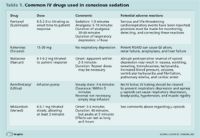Article
How to administer anesthesia in the urology office
Author(s):
The procedure should be of a durationand complexity that will permit the patient to recover and be discharged.
With appropriate patient selection, education, monitoring, equipment, staffing, and careful adherence to policies and procedures, many urologic procedures can be facilitated in the office setting by using office-based anesthesia (OBA).
Most urologists have prerequisite anesthesia education, training, and experience during their surgical residencies. In addition, to comply with Joint Commission on Accreditation of Health Care Organizations, most urologists have fulfilled credentialing and reappointment requirements at their local hospitals for administration of sedation and analgesia.
Among the many advantages for the OBA patient, improved clinical outcomes have been demonstrated. High-energy transurethral microwave thermotherapy can be performed with a wide range of drugs, but a post-treatment requirement for catheterization occurs in most patients (Alaska Med 1998; 40:3-5). As part of our OBA protocols, the use of remifentanyl (Ultiva)-an ester opiod that is rapidly metabolized by plasma esterases with no residual opiod activity 5 minutes after stopping infusion-has decreased our catheter requirement. The use of remifentanyl to prevent painful bladder spasms reduces the physical trauma of the spasms on the prostatic urethra.

Monitoring and equipment All patients are monitored continuously through both the procedure and the recovery phase. Monitoring parameters include respiratory rate, oxygen saturation, noninvasive blood pressure monitoring, cardiac rate and rhythm, level of consciousness, skin condition, and comfort level.
Excellent equipment has become readily available and affordable. Automatic defibrillators have fallen in price dramatically as public institutions have made large purchases. Computerized pulse oximetry and electrocardiac equipment has become affordable and reliable.
Battery and manual suction are available, although standard powered suction is more effective and recommended.
Backup power is readily available for your office computers, and an uninterrupted power system sufficient for 15 minutes should be used for monitoring equipment. Emergency lights should also be available.
Oxygen and backup supply of oxygen does not require costly in-wall installation. We use refillable large "H" tanks as the primary supply and small, readily movable "E" backup tanks from the same medical supplier as the hospital.
A "crash cart" with necessary supplies and drugs can be made, but third-party vendors may provide complete kits with computerized surveillance for outdated drugs.
An anesthesia infusion pump controls drug delivery, and the recommended minimal volume tubing should be purchased to eliminate unintended bolus.

Fentanyl is very inexpensive and reversed by naloxone (Narcan), but our preference is to use small doses of fentanyl that are augmented by remifentanyl. Remifentanyl is a unique opioid that has no fat distribution, is unaffected by renal function, and has a rapid onset, rapid distribution (equilibrates within 3 to 5 minutes), and elimination processes that are independent of duration of drug administration. Shutting off the infusion reverses remifentanyl faster than the intravenous administration of naloxone.
Newsletter
Stay current with the latest urology news and practice-changing insights — sign up now for the essential updates every urologist needs.

















